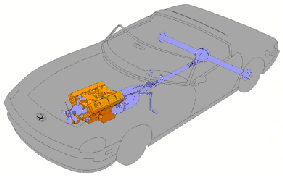 |
 |
 |
 |
An automobile engine extracts work from its chemical fuel by burning that fuel inside its cylinders and making the resulting burned gas do work on the engine.
Most engines have at least four cylinders, each of which requires four strokes to extract work from the fuel.
During the induction stroke, a piston moves out of the cylinder and fuel and air enter it.
During the compression stroke, the piston moves into the cylinder, compressing this fuel-air mixture to high density, pressure and temperature. An electric spark then ignites the mixture and converts it into extremely hot burned gas.
During the power stroke, the piston again moves out of the cylinder while the hot gas does work on it. This work is what powers the car.
Finally, during the exhaust stroke, the piston moves into the cylinder and ejects the burned gas. The cylinder then begins again with fresh fuel and air.
 The moving pistons turn a crankshaft so that power leaves the engine
through a rotating shaft. This shaft powers the transmission, which in turn
powers the car's wheels.
The moving pistons turn a crankshaft so that power leaves the engine
through a rotating shaft. This shaft powers the transmission, which in turn
powers the car's wheels.
The transmission provides adjustable mechanical advantage, so that the car
can climb steep hills or drive at high speeds on a level roadway.
It also allows the engine to be decoupled from the wheels so that the car
can come to rest without stopping the engine from turning.
V. S.